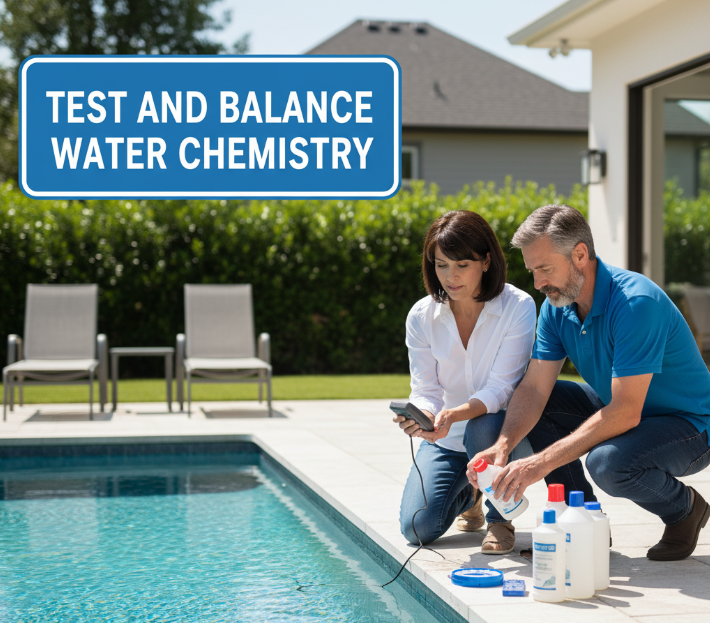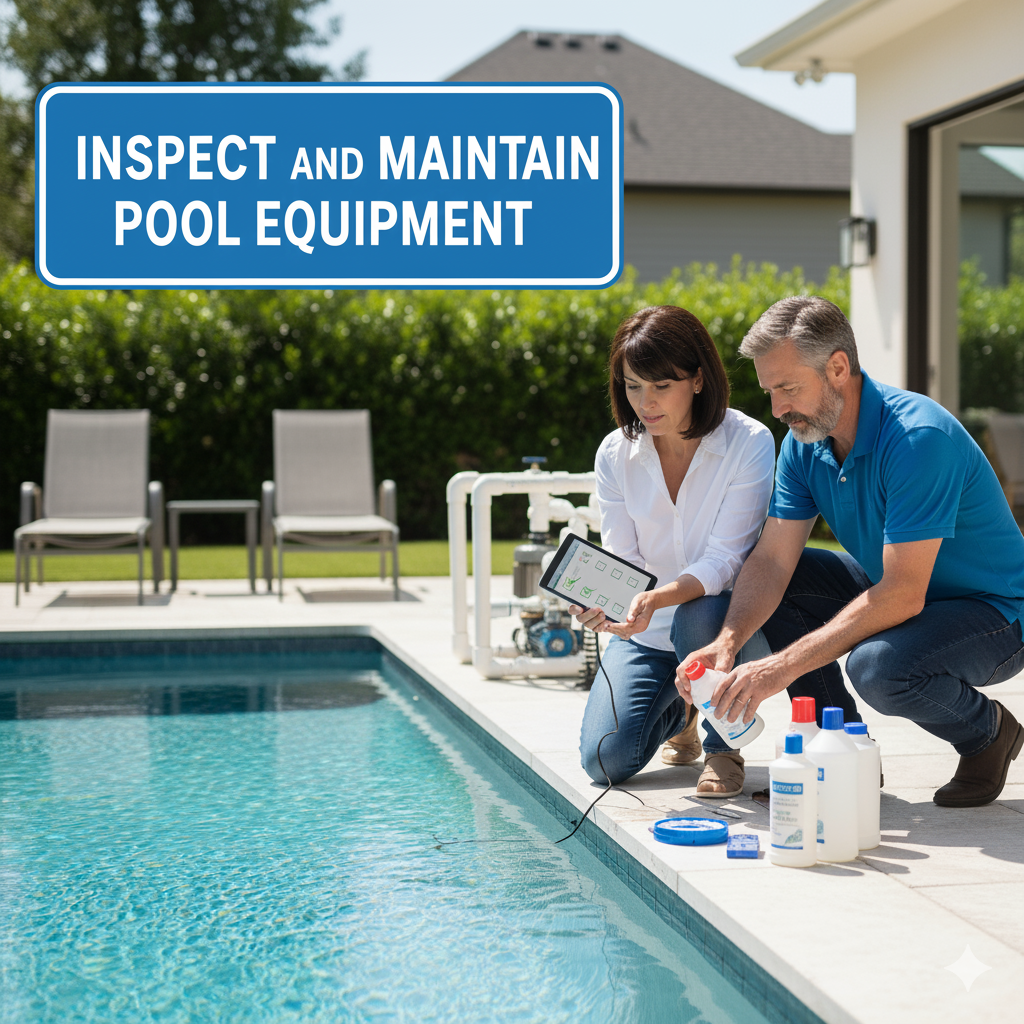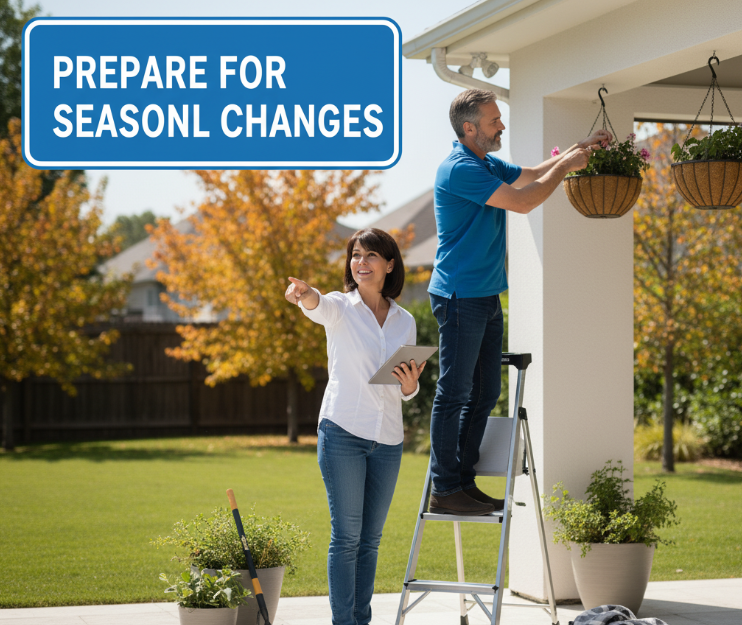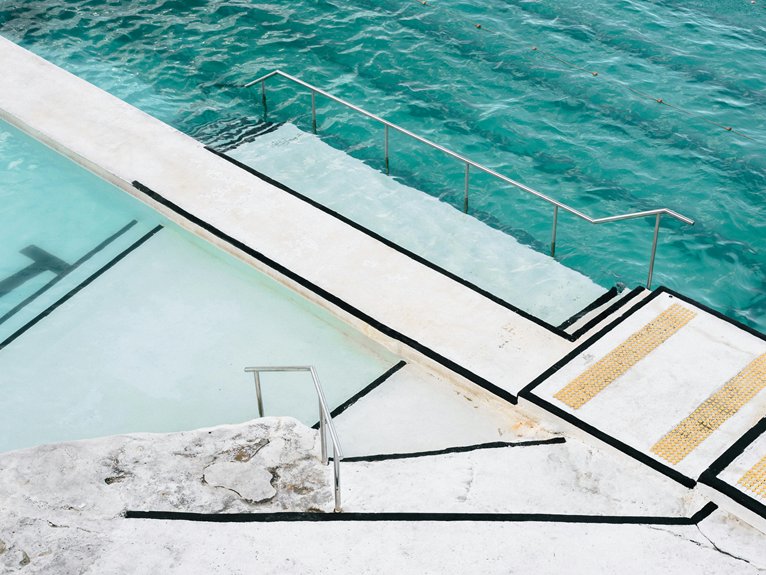Maintaining your home swimming pool requires a systematic approach to guarantee it stays clean and safe. You should regularly test and balance the water chemistry, focusing on pH and chlorine levels. Weekly cleaning is crucial, along with proper filtration maintenance. Neglecting these steps can lead to bigger problems down the line. By understanding the essential tasks, you’ll keep your pool inviting and extend its lifespan. Let’s explore these must-know steps further.
Key Takeaways
- Regularly test and balance water chemistry, maintaining pH between 7.2 – 7.6 and chlorine levels at 1 – 3 ppm.
- Clean the pool consistently by skimming daily, vacuuming weekly, and brushing bi-weekly to ensure clear and safe water.
- Maintain the filtration system by cleaning filters weekly and replacing them every 3 to 5 years for optimal performance.
- Inspect and maintain pool equipment, checking for unusual noises, leaks, and ensuring all baskets and lines are clear of debris.
- Manage algae growth by maintaining water chemistry, using a pool cover, and performing regular brushing, vacuuming, and shock treatments.
Test and Balance Water Chemistry

To maintain a clean and safe swimming environment, you should regularly test and balance your pool’s water chemistry at least once a week.
Start by measuring the pH levels, aiming for a range between 7.2 and 7.6. If the pH is too high or low, use pH increasers or decreasers to adjust accordingly.
Next, check the chlorine balance; ideal levels range from 1 to 3 parts per million (ppm). If chlorine is insufficient, add a suitable chlorine shock product.
Ensure your pool’s chlorine levels are between 1 to 3 ppm for optimal safety and clarity.
Regular testing guarantees water clarity, prevents algae growth, and protects both swimmers and pool equipment from potential damage.
Clean the Pool Regularly
Although it might seem like a chore, cleaning your pool regularly is essential for maintaining a safe and enjoyable swimming environment. Consistent pool cleaning prevents algae growth and maintains water clarity. Start by skimming the surface for debris removal, then vacuum the floor to eliminate dirt and sediment.
| Task | Frequency |
|---|---|
| Surface Skimming | Daily |
| Vacuuming | Weekly |
| Wall Brushing | Bi-weekly |
| Tile Cleaning | Monthly |
Investing time in these tasks keeps your pool pristine and guarantees a healthy experience for everyone.
Maintain the Filtration System
Maintaining the filtration system is essential for ensuring your pool stays clean and safe for swimming.
Proper maintenance of your pool’s filtration system is crucial for a clean and safe swimming environment.
Regular attention to this system enhances pump efficiency and prolongs its lifespan.
Here are key steps to follow:
- Check and clean the filter weekly.
- Schedule filter replacement every 3 to 5 years.
- Monitor pressure gauges; high readings indicate clogs.
- Inspect pump seals and connections for leaks.
- Keep the skimmer and pump baskets free of debris.
Inspect and Maintain Pool Equipment

Regularly inspecting and maintaining your pool equipment is vital for ideal performance and longevity.
Start by checking the pool pump for any unusual noises or leaks; these can indicate potential issues. Make certain the pump basket is clean to optimize circulation.
Next, examine the filter; if you notice a drop in pressure or cloudy water, it’s time for a filter replacement. Keeping an eye on the skimmer and return lines for debris buildup is also important.
Don’t forget to inspect all hoses and connections for wear and tear. Consistent maintenance prevents costly repairs and guarantees your pool remains inviting and efficient.
Manage Algae Growth
To keep your pool crystal clear and inviting, managing algae growth is essential. Implementing effective algae prevention tips can save you time and effort.
Here are some strategies to contemplate:
- Maintain proper water chemistry, especially pH and chlorine levels.
- Use a quality pool cover to minimize sunlight exposure.
- Regularly brush and vacuum your pool surfaces to remove debris.
- Contemplate natural remedies like adding beneficial bacteria or enzymes.
- Schedule routine shock treatments, especially after heavy rain or high usage.
Monitor Water Levels
Keeping your pool’s water level between 4 to 6 inches below the coping is essential for ideal performance. This range helps with effective pool skimming and prevents pump damage. Monitor water levels regularly, especially during hot weather, as water evaporation can greatly lower levels.
| Action | Frequency |
|---|---|
| Check water level | Weekly |
| Skim debris | Daily |
| Add water as needed | As necessary |
| Test water chemistry | Bi-weekly |
| Inspect for leaks | Monthly |
Prepare for Seasonal Changes

As the seasons change, it’s important to adjust your pool maintenance routine to accommodate varying weather conditions.
Proper preparation helps protect your investment. Here are some key steps to take into account:
Effective preparation is crucial for safeguarding your pool investment during seasonal transitions.
- Inspect and repair the cover pool for any damages.
- Clean and balance water chemistry before winter.
- Implement winterization techniques, such as draining plumbing lines.
- Store pool accessories and equipment properly to prevent damage.
- Monitor temperatures regularly to anticipate necessary adjustments.
Conclusion
By following these seven vital steps, you can guarantee your home swimming pool remains clean, safe, and inviting. Regularly testing and balancing water chemistry, along with diligent cleaning and maintenance, is essential for peak performance. Don’t overlook the importance of managing algae growth and preparing for seasonal changes to prolong your pool’s life. By staying proactive, you’ll enjoy crystal-clear water and a healthy swimming environment all year round.

